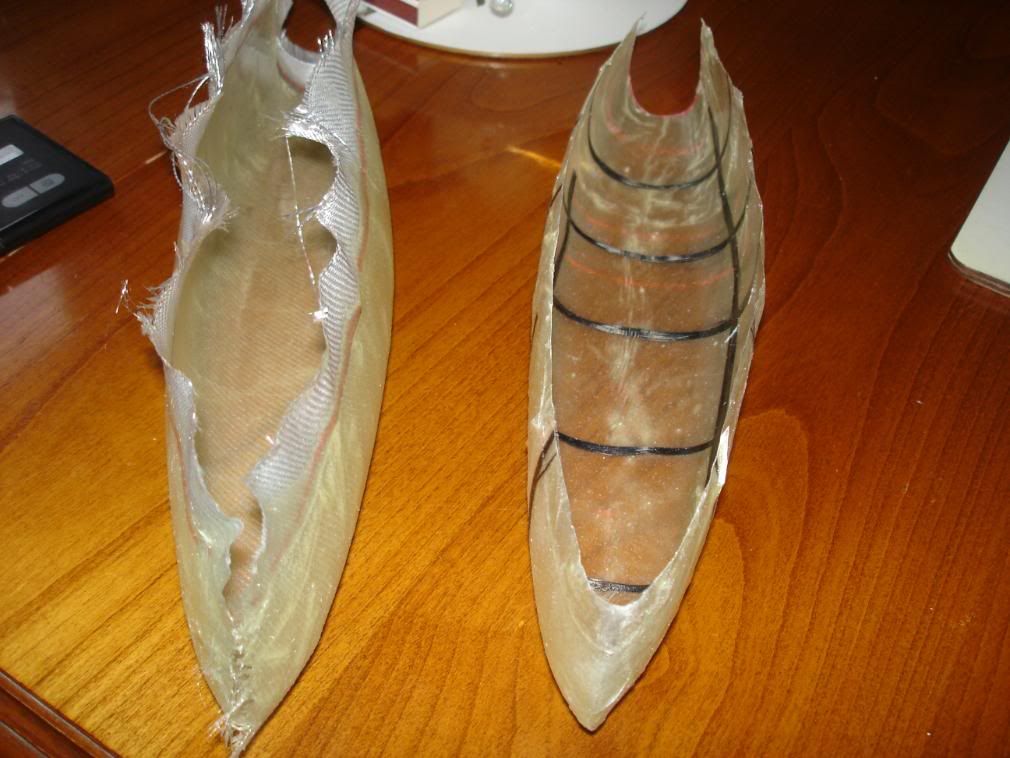Dear Brent, a good question is sometimes better than a good answer…
My opinion has been required about two or three points relevant to “scientific” footy model design
So, I will try to express my point of view - as far as possible - in an easy and clear way
1 - narrow versus broad hull : which one is the best ?
1.1 - computer calculations
I have tried to apply naval architecture method to estimate hull drag of our little models
I have used an “indirect” method ( professionals call it regression ) to guess drag based on hull main parameters ( example : lenght,beam,draft, displacement and so on ).
This is not a true measurement ( like a towing tank test ) but is ONLY a useful design tool to give a reliable preliminary estimation of drag.
I have modified frictional drag equations in order to take in account footy small size and speed ( laminar flow )
Even if a full agreement with full size test of footy has not been achieved ( yet ) I feel confident that comparison between different choices is reliable enough ( winner boat is the best on water and on computer screen )
A good confirm of the method is that both my “folgore” ( based on calculation) and the well known bobabout2 of brett mcCormack ( based on result of more than 30 different models ) have similar dimensions.
1.2 how to compare apple with oranges ?
to start with I have carried out Ia methodic comparison between hulls with :
1.2.1 same displacement
-same waterline lenght ( 300 mm )
-same displacement ( 500 gr )
-different beam ( ranging from 150 mm, down to 80 mm)
speed has been increased from almost zero up to about 1.5 kts
all boats are with same longitudinal distribution of volume ( same prismatic coefficient )
- narrow hull are deeper, beamier have a smaller draft -
narrow hull is winner on all speed range
1.2.2 same initial stability ( righting moment at no heel )
due the fact that reduced beam means reduced stability too, I have done a second comparison between hull of :
-same LWL
-same initial stability ( in other word, narrower hull must be heavier to have same righting moment a zero angle of heel )
narrower hull is the winner again, bat the gap between thin and beamy is smaller
1.2.3 same righting moment at given heel angle
due to the fact that when going upwind sailing boats - usually - are heeled, I have carried out a more complicated comparison between hulls with a 30° heel angle .
More details are needed to have a full picture of the situation ( for example beam on deck, and fin keel depth )
In this case , to compare apples with oranges, I have compared different hulls with same righting moment at same heel.
same heeling moment means that this is a race between boat with same rig ( or, at least same area and center of effort heeling arm )
the winner will be tha desing with minimum drag
Once again the thinner footy is the winner on all speed ranges
Both because no heel drag curve is an efficient one, as well due to side effect that additional drag due to heeling for thinner hull is much less than beamy and shallow boats
1.3 Diagonal boats
a comparison between a “standard” hull and a diagonal one ( few centimeters longer ) is a bit more complicated.
keeping constant the righting moment, longer hull have more wetted surface, but greater “hull speed limit”.
Results are very interesting because drag curves are x crossed ,to put it simple :
- below one knot, standard hull is the best one
- above one knot, diagonal hull is the best
+++
Conclusions :
even if my calculations are far from perfect, I have used all available engineering knowledge to perform a systematic study
current methods are not reliable enough to investigate very radical, or very unusual hull shapes, and for this reason the possibility of something “alien” is still to be considered as an open door ( planing ? submarine ? catamaran ? )
up to now I have not investigated beams under 80 mm on waterline
I will try to drop down to 40 mm, but reliability of results will be reduced too
hull beam is not everything
a winner should be also a boat a seaworthy and steerable model, capable to tack, jibe and race within a “good” range of wind speeds
a thinner hull seems to be the best ( thin vs broad ) from pure hydrodinamic point of view
a diagonal hull seems to be the best ( long vs short ) at high relative speeds
Flavio
Folgore ITA 5
Presto ITA 13 ( coming soon )
PS next time : few words about rocker and hull shape
 The freedom to do a complex shape like yours in a very short period of time keeps me coming back.
The freedom to do a complex shape like yours in a very short period of time keeps me coming back.

